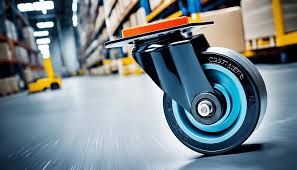In industrial and commercial operations, casters play an unsung yet crucial role. They are more than just simple attachments; they enhance mobility, safety, and efficiency on factory floors, retail environments, and healthcare facilities.
The importance of casters lies in their ability to transform stationary objects into mobile units, greatly facilitating logistical tasks. Historically, as industries evolved, so too did the need for reliable mobility solutions, leading to the development of various types of casters.
Indeed, the flexibility offered by innovations such as polyurethane wheels highlights the ongoing advancements in caster technology. These developments have allowed casters to meet and exceed the diverse movement requirements of various sectors today, making them integral components in achieving greater operational effectiveness.
Casters are generally categorized into three main types: swivel, rigid, and locking casters. Swivel casters allow for easy directional changes, making them indispensable in environments that require frequent maneuverability, such as hospitals and supermarkets.
These casters pivot on a central axis, allowing for greater agility and speed, essential in navigating tight spaces. On the other hand, rigid casters provide linear movement, making them ideal for transporting heavy loads over straight paths, often seen in manufacturing and assembly lines where path predictability is necessary.
Locking casters combine the attributes of swiveling and rigid casters but add a critical feature: the ability to secure a load in place. This feature is essential in scenarios where both movement and stability are required, such as in loading docks or during assembly operations.
Equally important is the choice of wheel material, which can range from rubber to metal. Rubber wheels offer a smooth ride over uneven surfaces and are less likely to damage floors, while metal wheels are more suited for rough, demanding industrial conditions.
Each caster has several key components, the most prominent being the wheel. Types of wheel materials include polyurethane, rubber, and steel, each catering to different applications. Polyurethane, for instance, is well-loved for its durability and floor protection capabilities, ensuring longevity even when handling heavier loads.
Meanwhile, rubber wheels provide a quieter operation and are thus preferred in environments where noise reduction is paramount, such as hospitals and libraries. Additional critical components include bearings and brackets. Bearings enable smooth wheel rotation and can be designed to handle varying loads and speeds.
Their design impacts performance and maintenance needs, affecting overall efficiency and functionality. Brackets support the wheel structure, contributing to the caster’s weight-carrying capacity and stability. Businesses can efficiently ensure their casters meet operational demands by incorporating the right balance of these elements.
The design of a caster is deeply rooted in principles of ergonomics and engineering. Ergonomically designed casters aim to reduce users’ strain, promote safety, and encourage productivity. Such designs consider the physical interaction between operators and equipment, mitigating risks associated with repetitive strain and overexertion.
Additionally, casters engineered for heavy-duty use integrate advanced materials and design technologies to handle substantial weights without compromising mobility. The complexities of caster design are evident in environments where high-load bearing is required. For instance, casters must be engineered in warehouses and manufacturing plants to withstand static and dynamic stress.
This necessitates a rigorous understanding of materials science and mechanical engineering that informs the decline in caster failure rates, ultimately improving workplace safety.
Caster technology has recently witnessed transformative innovations to enhance performance and sustainability. Manufacturers now incorporate advanced polymer compounds and eco-friendly materials, reducing the environmental impact without sacrificing quality or performance.
The growing emphasis on green manufacturing practices across industries drives this shift towards sustainability. Other developments include integrating more sophisticated braking systems and boosting safety in environments where precise control is critical.
Additionally, increased load capacities and enhanced rolling performance have allowed casters to meet the escalating demands of modern industries. As new technologies emerge, casters evolve, providing safer, more efficient, and environmentally aligned solutions.
Selecting the appropriate caster involves comprehensively evaluating environmental conditions, specific load requirements, and desired mobility characteristics. The process requires balancing numerous elements, such as the caster’s material suitability for certain surfaces and its load-bearing capacity. Ignoring these considerations can lead to operational inefficiencies, equipment damage, or even accidents.
One common misconception is that choosing a heavy-duty caster is always the best option. However, overestimating the needed capacity can increase operational costs while providing negligible benefits. Therefore, businesses must perform a detailed assessment to match caster specifications with their unique requirements, instilling functionality and cost-effectiveness into their operations.
The caster industry is following suit as industries worldwide lean towards automation and innovative technologies. Future developments in caster technology include self-adjusting caster systems, which autonomously modify their height and orientation to adapt to different loads and surface conditions.
Smart casters with IoT sensors are also on the horizon, promising real-time data collection and adaptive responses to environmental changes. These innovations reflect a broader trend of integrating technology to enhance operational efficiency and safety.
As such, the future of casters holds exciting possibilities, primarily driven by the demand for more innovative, adaptable, and environmentally friendly solutions. With continuous advancements, casters will remain at the forefront of enhancing industrial productivity and operational adaptability.
